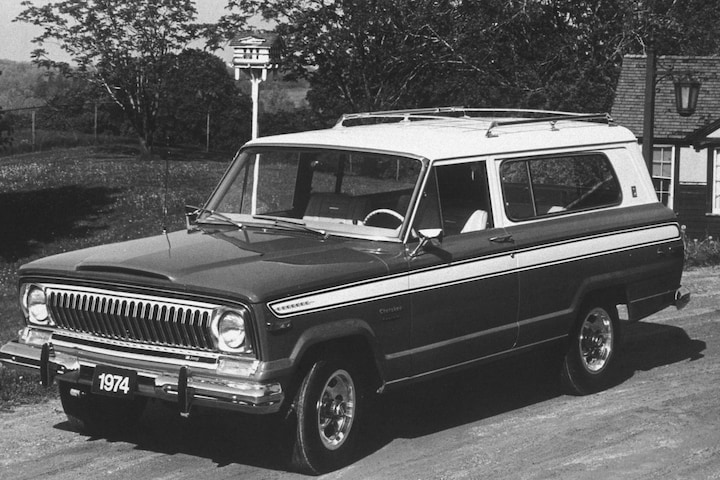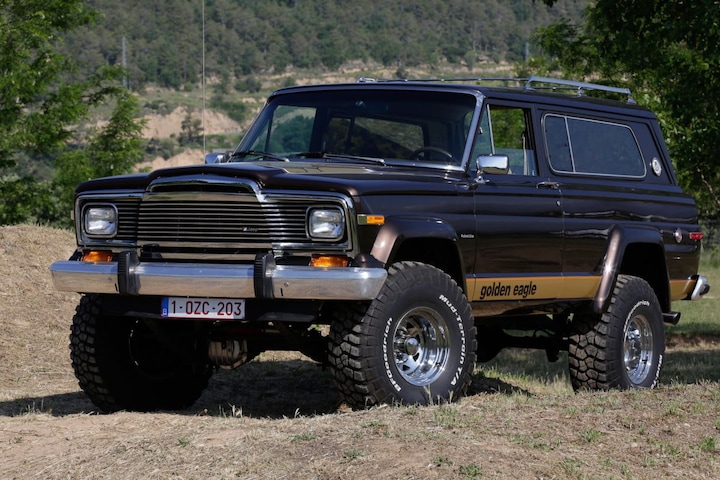Looking back on a great year 1974

Although the SUV is a relatively modern phenomenon, the idea of a comfortable car that can be used off-road has been around for a long time. Especially in the United States, where Jeep, among others, was already working on such cars in the 1960s. This led to a derivative of the Wagoneer in 1974, which would ultimately outlive its progenitor: the Jeep Cherokee SJ.
What was the start-up process of the Cherokee SJ like?
Long and full of uncertainties. To understand the origins of the Jeep Cherokee, we have to go back to just after World War II. Willys-Overland, the maker of the original military vehicle that would later be called Jeep, did build the Jeep Station Wagon with reasonable success, but it was a fairly utilitarian device that was clearly not conceived as a type of station wagon. That had to change with his spiritual successor. Jeep invested $20 million in developing a car that eventually appeared on the market in 1963 as the Jeep Wagoneer. Built on the full-size SJ platform, the Wagoneer was to America what the BMW X5 would be to Europe decades later: the model that looked like an off-roader but drove like a station wagon. An American station wagon, but still. To increase market opportunities, Jeep subsequently introduced a large number of variants on the Wagoneer theme, including a sporty two-door. You have to put that sporty in huge quotes. At the end of the decade, American Motors acquired the Jeep brand and in 1974 the two-door Wagoneer returned to the market as a standalone model on the same SJ platform. The Jeep Cherokee was born.

Jeep Wagoneer.
How was he received by the press and public?
Basically good. The special styling, in which the C-pillar was actually skipped and the car was given enormous rear side windows, was popular and Jeep had a firm grip on the market for large SUV-like vehicles with the Wagoneer. The technically heavily based Cherokee initially had the wind in its sails, especially because it enabled AMC to position the Wagoneer higher in the market. From now on, the Cherokee served customers who did not want to spend more, but were looking for a Wagoneer. He also immediately won prizes at the first Four Wheeler of the Year election in 1974.

How revolutionary was the Jeep Cherokee really?
Not. When it was introduced, it was already a ten-year-old platform with leaf springs and a ladder chassis. Initially, disc brakes were an option and the Cherokee had standard drum brakes all around. Except for the doors, it was a clone of the ten-year-old Wagoneer, which was the first to receive new technology. The Cherokee then followed at an appropriate distance. But: it was one of the first cars with the Sport Utility Vehicle designation; it was already in the brochure in 1974.

What were the choices during the market introduction?
A big one or a very big one, at least as far as the engine is concerned. The basic version already had a 4.2-liter inline six, good for a monstrous 110 American horsepower, but there were also variants with a 5.9-liter V8. Good for 175 HP with a two barrel carburetor or 195 HP with a four barrel carburetor. But if you really wanted the cream of the crop, you went for the 6.6-liter V8. Good for approximately 215 hp and 434 Nm, although that depended somewhat on which emission requirement applied at the time of delivery. It reportedly makes the Jeep Cherokee the fastest SUV you could buy. It is still the largest power source that Jeep has ever supplied in a model, even the Trackhawk ‘only’ came to 6.4 liters. Although it did have a big compressor.
What were its competitors?
Jeep was early with the Wagoneer, but when the Cherokee appeared on the market, the Range Rover was already there, as well as the Ford Bronco and Chevrolet K5 Blazer from its own country. But perhaps the Cherokee suffered most from the car to which it also owed its existence: the Wagoneer. Especially when AMC made the strange decision in 1977 to supply the Cherokee as a four-door, making it a Wagoneer with a different name.

Ford Bronco.
Any details during his life?
Surprisingly little, except for the introduction of the aforementioned four-door in 1977. Furthermore, the Cherokee followed the Wagoneer at an appropriate distance. It had disc brakes earlier and was also earlier in introducing the more user-friendly Selec-Trac four-wheel drive system, while the Cherokee had to make do with the existing Quadra-Trac.

Which version appeals most to the imagination?
Of course the killer 6.6-liter V8, so you can say you have the biggest. Or the special Golden Eagle version from 1979 with all kinds of gold details and a denim interior. But on our side of the pond, SJ Cherokees are already so rare that they actually all capture the imagination.

What has been the impact of the Cherokee?
The impact of the original Cherokee SJ was not very great, mainly because it was not much more than a Wagoneer with fewer doors. But the Cherokee name would return in 1983 on the second generation, the XJ. That was the first completely new car for Jeep since, there it is again: the Wagoneer. The second generation was considerably more modern, including a self-supporting body. Although the Wagoneer lasted longer than the Cherokee, it eventually disappeared from the range in the early 1990s. The Cherokee designation lasted until last year, while the Wagoneer model name returned in 2022.

Jeep Cherokee XJ
How many are left?
According to our data supplier Vinacles, there are 103 Cherokees registered in the Netherlands with a valid license plate. This concerns the construction years 1974 to 1982. Construction year 1979 is best represented with 29 copies.
– Thanks for information from Autoweek.nl